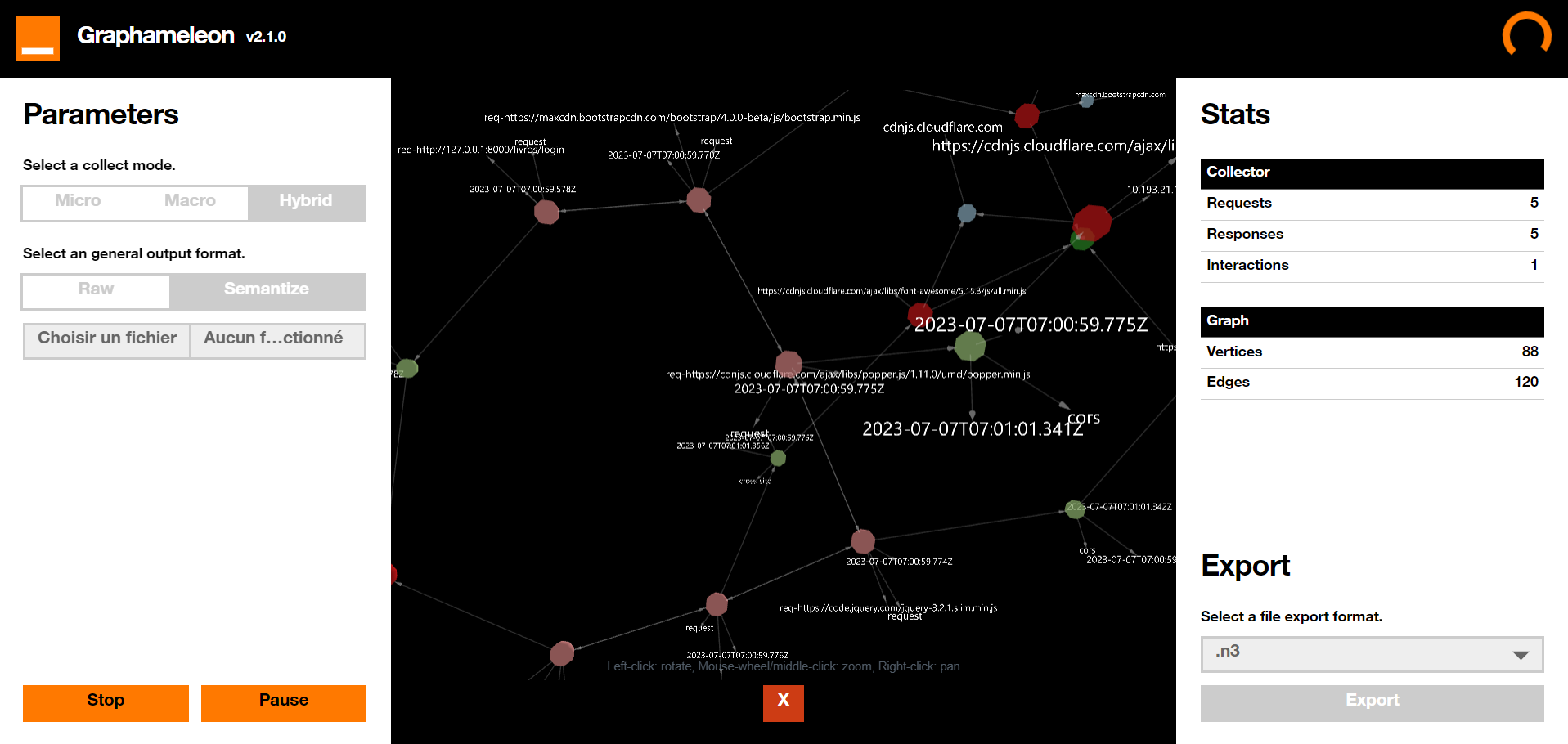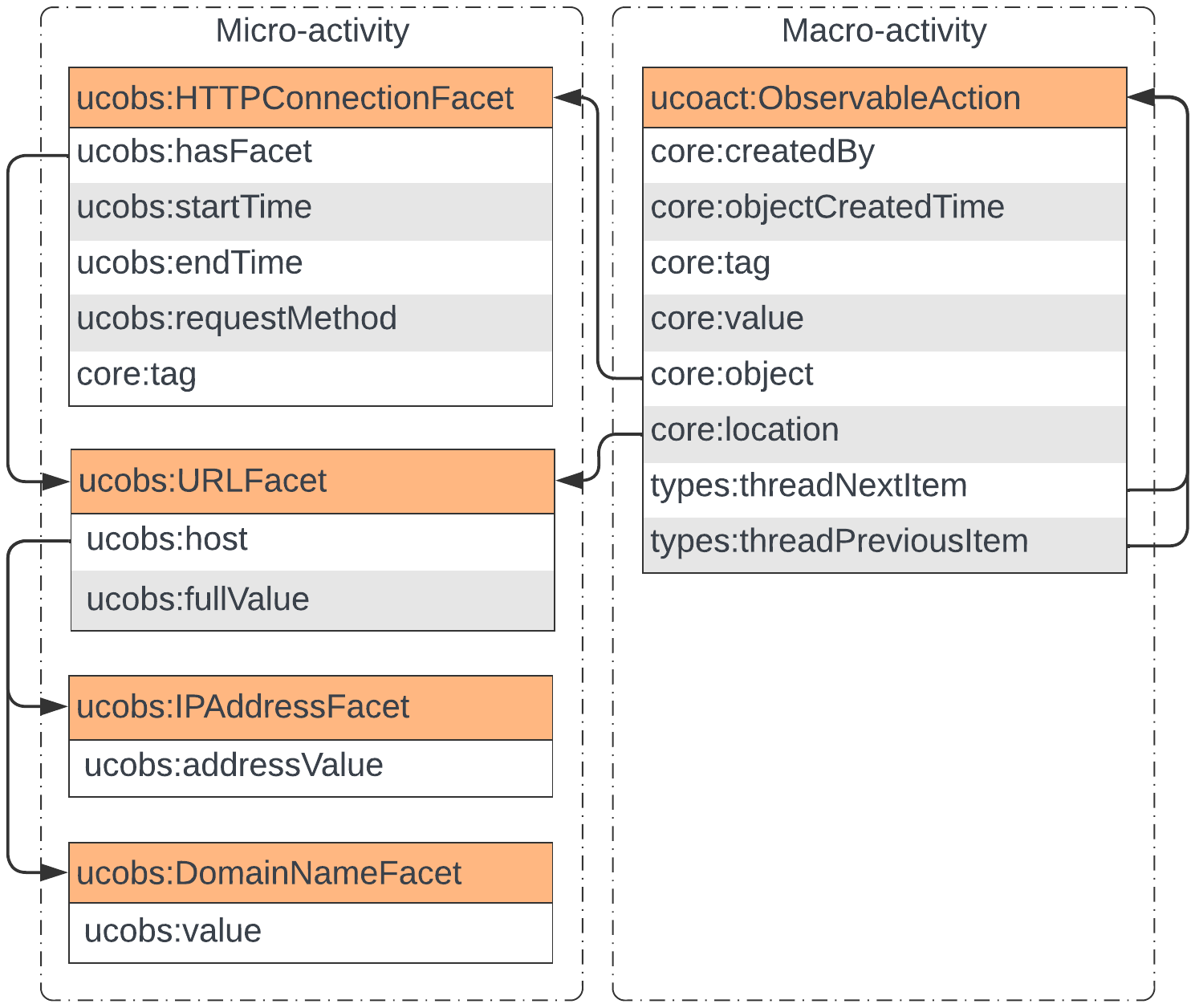Graphameleon is a Web Browser Extension which collects and semantizes Web navigation traces.
Following research on the NORIA-O and DynaGraph projects, the Graphameleon Web extension brings visualization and recording of Web navigation traces at the browser level. Then, leveraging knowledge graph representations, to perform User and Entity Behavior Analytics (UEBA) and Anomaly Detection (AD).
The extension incorporates an internal semantical mapping module that relies on the RMLmapper library to construct a RDF knowledge graph during navigation. Additionally, it utilizes the React-Force-Graph visualization library, allowing users to view their navigation traces in a 3D representation of the knowledge graph.
You may want to look at the ACM SIGWEB/Graphameleon video for an overview of the Graphameleon proposal. See also the TWC2024-Graphameleon-demo.webm video (in the docs/demo/ folder) for a short demo of how the Graphameleon Web extension works.
If you use this software in a scientific publication, please cite:
Lionel Tailhardat, Benjamin Stach, Yoan Chabot, and Raphaël Troncy. 2024. Graphameleon: Relational Learning and Anomaly Detection on Web Navigation Traces Captured as Knowledge Graphs. In The Web Conference 2024, WWW '24, Singapore, May 13--17, 2024, Proceedings. https://doi.org/10.1145/3589335.3651447
BibTex format:
@inproceedings{graphemeleon-2024,
title = {{Graphameleon: Relational Learning and Anomaly Detection on Web Navigation Traces Captured as Knowledge Graphs}},
author = {{Lionel Tailhardat} and {Benjamin Stach} and {Yoan Chabot} and {Rapha\"el Troncy}},
booktitle = {{The Web Conference 2024, WWW '24, Singapore, May 13--17, 2024, Proceedings}},
year = {2024},
doi = {10.1145/3589335.3651447}
}🇫🇷 Si vous utilisez ce logiciel dans une publication scientifique, merci de citer :
Lionel TAILHARDAT, Benjamin STACH, Yoan CHABOT, Raphaël TRONCY. 2024. Graphaméléon : apprentissage des relations et détection d’anomalies sur les traces de navigation Web capturées sous forme de graphes de connaissances. In Plate-Forme Intelligence Artificielle (PFIA), IC track, July 01-05, 2024, La Rochelle, France.
Pour une courte démo du fonctionnement de Graphaméléon, vous pouvez consulter la vidéo PFIA2024-Graphameleon-demo.webm (dans le dossier docs/demo/).
To start using Graphameleon, you have two options:
- Download a release and unzip it.
- Build the component.
Once you have completed this step, proceed to the Run step described below.
Pre-requisites:
- Downloading and installing Node.js and npm
- Cloning the repository to your computer
- Installing third-party npm modules:
npm install
Create a build for Firefox:
# Firefox is considered to be the browser by default for the build process
npm run startCreate a build for Chrome:
npm run start:chromeCreate a build for Edge:
npm run start:edgeClean the distribution file:
npm run clean- First, open a firefox navigation window and go to the following page:
about:debugging#/runtime/this-firefox - In the Temporary Extensions section, click on the Load Temporary Add-on... button.
- Then, select the
manifest.jsonfrom the./distor any other file from the same directory to load the extension.
The Graphameleon Extension is now loaded on Firefox !
- First, open a chrome navigation window and go to the following page:
chrome://extensions/ - Enable the Developer Mode on the top-right corner.
- Click on the Load unpacked button.
- Then, select the
manifest.jsonfrom the./distor any other file from the same directory to load the extension.
The Graphameleon Extension is now loaded on Chrome !
- First, open an edge navigation window and go to the following page:
edge://extensions/](edge://extensions/ - Enable the Developer Mode on the left navigation bar.
- Click on the Load unpacked button.
- Then, select the
manifest.jsonfrom the./distor any other file from the same directory to load the extension.
The Graphameleon Extension is now loaded on Edge !
The general process for performing data capture is as follows:
- Open the Graphameleon component, this brings a Graphameleon panel
- Select a capture mode (see table below for details):
- micro
- macro
- hybrid
- Select a general output format:
- Start data capture with the Record button
- Navigate the Web in the other Web browser tabs
- Stop data capture with the Stop button from the Graphameleon panel
- Select a file export format:
- Export the data with the Export button, the resulting data will be saved in the Web browser's default download folder.
The following table shows the type of data collected by the Graphameleon Web extension as a function of the capture mode (micro-activity vs macro-activity), and grouped by their scope (request vs interaction vs both):
| Scope | Feature/header name | Micro | Macro |
|---|---|---|---|
| Request | Method | Yes | Yes |
| URL | Yes | Yes | |
| IP | Yes | Yes | |
| Domain | Yes | Yes | |
| Sec-Fetch-Dest | Yes | Yes | |
| Sec-Fetch-Site | Yes | Yes | |
| Sec-Fetch-User | Yes | Yes | |
| Sec-Fetch-Mode | Yes | Yes | |
| Interaction | EventType | - | Yes |
| Element | - | Yes | |
| Base URL | - | Yes | |
| Both | User-Agent | Yes | Yes |
| Start time | Yes | Yes | |
| End time | Yes | Yes |
The following class diagram defines the concepts and properties used for the semantic representation of micro-activities (left) and macro-activities (right):
The names of concepts and properties used here are defined within the UCO vocabulary, the following namespaces apply:
core: https://ontology.unifiedcyberontology.org/uco/core#ucobs: https://ontology.unifiedcyberontology.org/uco/observable#types: https://ontology.unifiedcyberontology.org/uco/types#
For micro-activities, the presented classes and properties accurately describe a sequence of requests captured at the Web browser level.
- An HTTP request is represented by an entity of the class
ucobs:HTTPConnectionFacet, and its headers are represented by specific properties such asucobs:startTimeanducobs:endTimefor timestamps, andcore:tagfor fetch metadata request headers. - Since an IP address or URL can be common to multiple requests (e.g., a user repeating the same call to a website, a website with various services hosted on the same server), these elements shall be materialized through the
ucobs:IPAddressFacetanducobs:URLFacetclasses respectively, and cross-references between entities is built through properties such asucobs:hasFacetanducobs:host.
Macro-activities further enhance the modeling by allowing the description of interactions.
- We consider the user interactions (e.g., click on a hyperlink, on a Web browser button) as
ucoact:ObservableActionclass instances, with relations to the aboveucobs:HTTPConnectionFacetanducobs:URLFacetentities for describing the context in which they occur. - Further, we consider the
types:threadNextItemandtypes:threadPreviousItemproperties from UCO for modeling the chronology of activity traces.
Please check the graphameleon-ds repository for examples of data captured using the Graphameleon Web extension.
📁 graphameleon
├───📁 mapping/ <Default semantical mapping rules (RML, YARRRML)>
│ └───...
├───📁 public/
│ ├───📁 assets/ <All assets files>
│ │ └───...
│ ├───📄 index.html
│ ├───📄 manifest.chrome.json <Manifest V3 for Chrome based browsers>
│ └───📄 manifest.firefox.json <Manifest V2 for Firefox browser>
├───📁 src/ <Extension source code>
│ ├───📁 app/ <Application-specific files>
│ │ ├───📁 components/ <React UI components and panels>
│ │ │ └───...
│ │ └───📄 App.jsx <React app>
│ ├───📁 scripts/ <Extension scripts (background, content) and modules>
│ │ ├───📁 modules/
│ │ │ ├───📄 Interaction.js <Interaction collector>
│ │ │ ├───📄 Manager.js <Managing communications, collections and mapping>
│ │ │ ├───📄 Mapper.js <Mapping management, graph builder>
│ │ │ └───📄 Request.js <Request collector>
│ │ ├───📁 utils/
│ │ │ ├───📄 mapping.js <Raw string default semantical mapping rules (RML)>
│ │ │ ├───📄 settings.js <Cross-browser specifiations>
│ │ │ └───📄 tools.js <Handcrafted usefull functions>
│ │ ├───📄 background.js <Background script: manager, mapper and request collector>
│ │ └───📄 content.js <Content script: interaction collectors>
│ └───📄 index.jsx
└───...
Copyright (c) 2022-2023, Orange. All rights reserved.

